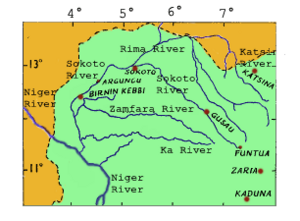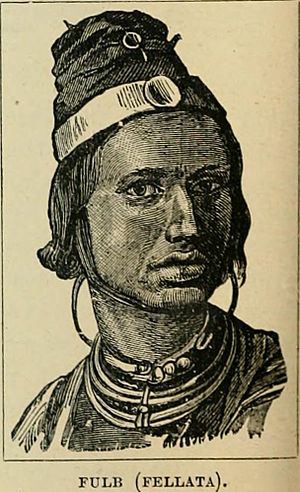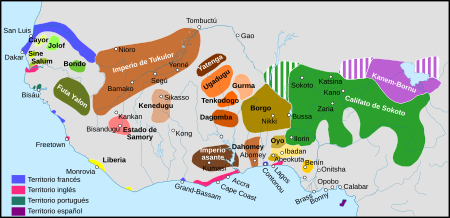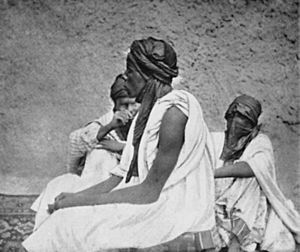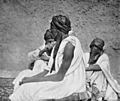Sokoto Caliphate facts for kids
Quick facts for kids
Sokoto Caliphate
Daular Khalifar Sakkwato
al-Khilāfat fi'l-Bilād as-Sūdān دَوْلَةُ الخَلاِفَة فَي بِلَاد السُودَان |
|||||||||||||||||||||||||||||||||||||
|---|---|---|---|---|---|---|---|---|---|---|---|---|---|---|---|---|---|---|---|---|---|---|---|---|---|---|---|---|---|---|---|---|---|---|---|---|---|
| 1804–1903 | |||||||||||||||||||||||||||||||||||||
|
Flag
|
|||||||||||||||||||||||||||||||||||||
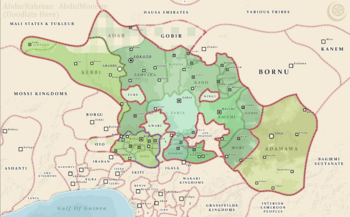
Sokoto Sultanate during the reign of Sultan Ahmadu Rufai
|
|||||||||||||||||||||||||||||||||||||
| Capital |
|
||||||||||||||||||||||||||||||||||||
| Common languages | |||||||||||||||||||||||||||||||||||||
| Religion | Sunni Islam | ||||||||||||||||||||||||||||||||||||
| Government | Caliphate | ||||||||||||||||||||||||||||||||||||
| Caliph / Amir al-Mu'minin |
|||||||||||||||||||||||||||||||||||||
|
• 1804-1817
|
Usman dan Fodio (first) | ||||||||||||||||||||||||||||||||||||
|
• 1902–1903
|
Muhammadu Attahiru (last) | ||||||||||||||||||||||||||||||||||||
| Grand Vizier | |||||||||||||||||||||||||||||||||||||
|
• 1804–1817
|
Abdullahi dan Fodio (first) | ||||||||||||||||||||||||||||||||||||
|
• 1886-1903
|
Muhammadu al-Bukhari (last) | ||||||||||||||||||||||||||||||||||||
| Legislature | Shura | ||||||||||||||||||||||||||||||||||||
| Historical era | Fula jihads | ||||||||||||||||||||||||||||||||||||
|
• Founded
|
4 February 1804 | ||||||||||||||||||||||||||||||||||||
|
• Tabkin Kwatto
|
1804 | ||||||||||||||||||||||||||||||||||||
|
• First Succession Crisis
|
1832 | ||||||||||||||||||||||||||||||||||||
|
• Battle of Gawakuke
|
1837 | ||||||||||||||||||||||||||||||||||||
| 1 January 1897 | |||||||||||||||||||||||||||||||||||||
|
• Second Battle of Burmi
|
29 July 1903 | ||||||||||||||||||||||||||||||||||||
| Currency | Dirham | ||||||||||||||||||||||||||||||||||||
|
|||||||||||||||||||||||||||||||||||||
The Sokoto Caliphate (دولة الخلافة في بلاد السودان), also known as the Sultanate of Sokoto, was a large Sunni Muslim state in West Africa. It was started by Usman dan Fodio in 1804. This happened during the Fulani wars after he defeated the Hausa Kingdoms.
The Caliphate's borders covered parts of what are now Cameroon, Burkina Faso, Niger, and Nigeria. By 1837, it had about 10 to 20 million people. This made it the most populated empire in West Africa at that time. The British and Germans took over the area in 1903. This led to the end of the Caliphate. Its lands became part of the new Northern Nigeria Protectorate and Kamerun.
The Caliphate began after the Hausa King Yunfa tried to harm Usman dan Fodio in 1802. Usman and his followers moved to Gudu in February 1804 to be safe. His followers chose Usman as their leader, the Commander of the Faithful (Amīr al-Muʾminīn). By 1808, the Sokoto Caliphate controlled many northern Nigerian states. Under its sixth leader, Ahmadu Rufai, the state grew to its largest size. It covered a huge area of West Africa. In 1903, the last leader, Attahiru, was killed by British forces. This marked the end of the Caliphate.
The Sokoto Caliphate connected over 30 different smaller states called emirates. It had a population of 10 to 20 million people. It was a loose group of emirates. They all respected the Amir al-Mu'minin, who was the Sultan of Sokoto. The Caliphate brought many years of economic growth to the region. During the Fulani War, many non-Muslim people were taken as slaves. These enslaved people worked on farms. By 1900, Sokoto had at least 1 million, and possibly up to 2.5 million, enslaved people.
Even though European rulers ended the Caliphate's political power, the title of Sultan remained. It is still an important religious position for Sunni Muslims in the region today. Usman dan Fodio's actions inspired other similar movements in West Africa. These led to the creation of Islamic states in areas now known as Senegal, Mali, Ivory Coast, Chad, the Central African Republic, and Sudan.
Contents
History of the Caliphate
How it Started
In the 17th and 18th centuries, the Bornu Empire was the main power in the region. But its power weakened over time. By 1759, its rulers lost control of important trade routes. Smaller cities that were once part of the empire became independent. By 1780, many separate states existed in the area.
The fall of the Songhai Empire in 1591 also created a power gap. Several Hausa sultanates grew to fill this space. Three important ones were Gobir, Kebbi, and Zamfara. These kingdoms often fought each other, especially to capture people for slavery. To pay for these wars, they heavily taxed their people.
The area between the Niger River and Lake Chad was home to the Fulani, Hausa, and other groups like the Tuareg. Many people had become Muslim centuries before. However, some local traditional beliefs still existed, especially among the ruling families. In the late 1700s, there was a rise in Islamic teaching across the Hausa kingdoms. Many teachers were connected through a shared way of studying Islam. Scholars from North Africa came to the Hausa lands. They taught about returning to strict Islamic traditions. One very important scholar was Muhammad al-Maghili. He brought a specific type of Islamic law to Nigeria.
The Fulani Wars
Usman dan Fodio was an Islamic scholar and a Fulani man. He taught and preached in the city of Gobir with the support of its Hausa leaders. But when Yunfa, one of dan Fodio's former students, became the Sultan of Gobir, he limited dan Fodio's activities. Eventually, he forced dan Fodio to leave for Gudu. Many people left Gobir to join dan Fodio. He also gained new followers from other areas.
Feeling threatened, Sultan Yunfa declared war on dan Fodio on February 21, 1804.
Usman dan Fodio's followers chose him as the "Commander of the Faithful" (Amir al-Mu'minin). This marked the start of the Sokoto state. Usman dan Fodio then chose several "flag bearers" from his followers. This created an early political structure for the new state. He declared a holy war against the Hausa kings. Dan Fodio gathered his mostly Fulani "warrior-scholars" to fight Gobir.
Despite early defeats, dan Fodio's forces began to capture key cities in 1805. The Fulani used clever fighting tactics to win. They gained support from ordinary people who were tired of the Hausa kings' harsh rule and high taxes. Even some non-Muslim Fulani joined dan Fodio. The war lasted from 1804 to 1808. It led to many deaths. Dan Fodio's forces captured Katsina and Daura. They took the important kingdom of Kano in 1807. Finally, they conquered Gobir in 1809. In the same year, Muhammed Bello, dan Fodio's son, founded the city of Sokoto. This city became the capital of the Sokoto state.
The war also led to a large increase in the number of enslaved people. By 1900, the Sokoto state had between 1 million and 2.5 million enslaved people. This was a very large number for any society at that time.
Important Leaders and Emirates
| Name | Emirate |
|---|---|
| Abu Hamid | Zurmi Emirate |
| Umar Dallaji | Katsina Emirate |
| Suleiman dan Abu Hamma | Kano Emirate |
| Yaqubu dan Dadi | Bauchi Emirate |
| Ishaq | Daura Emirate |
| Musa ibn Suleiman Ibn Muhammad | Zazzau Emirate |
| Ibrahim Zakiyul Kalbi | Katagum Emirate |
| Modibbo Adama | Adamawa Emirate |
Growth of the Sokoto Caliphate
From 1808 to the mid-1830s, the Sokoto state grew larger. It gradually took over western plains and parts of Yorubaland. It became one of Africa's biggest states. It stretched from modern-day Burkina Faso to Cameroon. It included most of northern Nigeria and southern Niger. At its peak, the Sokoto state had over 30 different emirates.
The state's political system had the Sultan of Sokoto ruling from Sokoto city. Each emirate's leader was chosen by the Sultan. They were given a lot of freedom to govern their own areas. Much of the state's growth happened through building many new fortified towns called ribats. These ribats had walls, schools, markets, and other buildings. They helped the state expand by creating new cities. They also helped settle the Fulani people and supported the growth of farms. These farms were very important for the economy.
The Caliphate's growth changed the local people's lives a lot. Many conquered groups joined the Caliphate. They adopted Islam and became part of its political and social system. Other communities fought against the Caliphate's rule. This led to conflicts that sometimes lasted for years. The biggest change was the spread of Islam. The Sokoto Caliphate was very Islamic. It actively tried to convert people in the lands it conquered. Because of this, Islam became the main religion in the region. This greatly affected local cultures, laws, and social customs. Islamic law (Sharia) was put in place. This changed things like property rights, marriage, and criminal justice. Not all local people accepted the Caliphate's rule. Some communities kept their traditional religions. There were also armed rebellions against the Caliphate. Some of these rebellions succeeded in gaining local freedom.
The expansion of the Sokoto Caliphate happened in three main steps. First, from 1804 to 1808, power was made strong in Gobir and nearby Hausa states. Winning battles against these rulers brought a lot of support. This set up the base for future growth. The second step (1809-1815) was expansion to the east and south. It reached the Bornu empire and Yorubaland. Dan Fodio and his helpers led many holy wars. They said these wars were against non-Islamic practices. These wars succeeded not just because of military strength. They also appealed to the Fulani people's desire for new lands and to bring people into the Muslim community. The Fulani were key to the Caliphate's growth. The final step (1815-1840) involved making the Caliphate stronger and fighting small battles against groups that resisted. By this time, the Caliphate was one of Africa's largest empires. It covered parts of present-day northern Nigeria, Niger, Cameroon, and Benin.
This growth led to big changes for local people. The spread of Islam was a major result. It changed the religious map of the region. Islamic law was put in place. This affected local customs, especially about property, marriage, and criminal justice. This religious influence still shapes the region today. Also, the Caliphate's way of governing was put in place in conquered areas. The Caliphate set up a system of emirates. Emirs were chosen to oversee local rule. The social order had the Sultan and ruling families at the top. Below them were free Muslims, then non-Muslims, and then enslaved people. This system greatly changed the region's political setup.
Into the Nupe Kingdom
The Nupe Kingdom was a strong state in Central Nigeria. The Sokoto Caliphate conquered it in the early 19th century. This was part of the Caliphate's plan to expand. Sokoto forces, led by Usman dan Fodio's brother, Abdullahi dan Fodio, moved towards the Nupe Kingdom around 1806. The Nupe Kingdom was rich and had a strong army. But it was divided by arguments over who should rule. Abdullahi dan Fodio used these problems to attack the Nupe Kingdom.
The Nupe Kingdom fought back, but was eventually defeated. Its ruler, Etsu Majiya II, was killed in battle. The kingdom fell to Sokoto forces around 1808. After the conquest, the Sokoto Caliphate set up the Bida Emirate in the Nupe Kingdom. They chose a local Fulani leader, Mallam Dendo, to be the emir. He ruled for the Sultan of Sokoto. The emir had to enforce Islamic law and send payments to the Sultan. The conquest of the Nupe Kingdom had big effects. Islam became the main religion. The Arabic writing system was used for the local Nupe language. The Caliphate also created new trade routes and markets. This led to economic changes.
Into the Oyo Empire
The Oyo Empire was a powerful kingdom in West Africa in the 18th century. It was located in what is now southwestern Nigeria. But by the early 19th century, the Oyo Empire was weakening. This was due to internal fights, disagreements over who would rule, and attacks from outside enemies. The Sokoto Caliphate, on the other hand, was growing stronger.
The Sokoto Caliphate's main involvement with the Oyo Empire was through Ilorin. Ilorin was a northern Yoruba state that was part of the Oyo Empire. Ilorin, with support from the Sokoto Caliphate, attacked the Oyo Empire many times. These attacks, along with internal problems, caused the Oyo Empire to finally collapse by the mid-19th century.
Into other parts of Hausaland
Parts of present-day Niger, especially areas near Nigeria, were conquered by the Sokoto Caliphate. For example, the town of Birnin Konni was an important center for the Caliphate in this region. The Sokoto Caliphate also spread its influence into northern Benin, which borders Nigeria to the west.
The way they expanded into these areas was similar to how they expanded within Nigeria. The Caliphate launched military campaigns against local rulers. They often took advantage of internal conflicts and divisions. After conquering an area, the Caliphate would usually set up an emirate. An emir would be appointed to govern on behalf of the Sultan of Sokoto. These new rulers were expected to enforce Islamic law and send payments to the Sultan.
Into the Kanem-Bornu Empire
The last major expansion of the Fulani forces was their role in the fall of the Sayfawa dynasty in 1846. The Sokoto Caliphate did not directly overthrow the rulers of the Bornu empire. However, the movements of the 19th century certainly affected it. The empire was weakened by internal conflicts and outside threats. These threats included the growing Sokoto Caliphate and other groups.
The Fulani forces, under Usman dan Fodio, tried to conquer Borno in 1808. Borno was ruled by Mai Dunama IX Lefiami. They partly succeeded. They burned the capital, Ngazargamu, and defeated the main army of the Mai of Borno.
Influence on other Fula States
The 19th century was a time of big Islamic changes and movements in West Africa. The Sokoto Caliphate was just one of several strong states that appeared then. In present-day Mali, the Massina Empire and the Toucouleur Empire were examples of states built in similar ways. They also involved Islamic changes and military expansion.
The Massina Empire was an early 19th-century Fulani state. It was founded by Seku Amadu. He started a movement among the Fulani people in the region. In the early 1800s, Seku Amadu was inspired by Usman dan Fodio's teachings and the Sokoto Caliphate's success. He was given permission by Fodio to lead a movement in the Massina region. Seku Amadu's forces overthrew the old rulers and set up a new state. Its capital was Hamdullahi. The Massina Empire grew mostly through military conquests. It controlled the Inner Niger Delta and parts of the surrounding areas. Important places like Timbuktu and Djenné came under its control.
The Massina Empire ruled with a strict interpretation of Islamic law. Seku Amadu made new laws and social changes. He outlawed many traditional practices. He also encouraged people to convert to Islam. However, the Massina Empire faced resistance. Some local communities did not want Islamic law or a central government. It also faced threats from nearby states, like the Toucouleur Empire. The Massina Empire fell to the Toucouleur Empire in 1862. Even though it lasted a short time, the Massina Empire greatly affected the region. It played a key role in spreading Islam.
The Toucouleur Empire was another important West African state in the 19th century. It was in what is now Mali, Senegal, and Guinea. It was founded by El Hadj Umar Tall, an Islamic leader. He wanted to create an Islamic state and bring people into the Muslim community. Umar Tall began his holy war in the 1850s after studying in the Sokoto Caliphate. In 1854, Umar Tall declared a holy war against the non-Islamic practices of local rulers. He built a large army. It included his own people, other Muslim groups, and enslaved individuals. With this army, he won many battles against West African kingdoms. These included the Kingdom of Segou in 1861 and the Massina Empire in 1862. At its largest, the Toucouleur Empire stretched from modern-day Senegal to Timbuktu. Its capital was Segou.
The Wassoulou Empire, founded by Samori Ture, was also an important Islamic state. It was in what is now Guinea, Sierra Leone, and Ivory Coast. The Wassoulou Empire was known for its strict practice of Islam.
During the 18th century and later, the Wolof people were greatly affected by the movements spreading across West Africa. These Islamic campaigns faced strong resistance from the Wolof kingdoms. However, in the 19th century, as French colonial forces began taking land in West Africa, the Wolof resisted French rule and increasingly turned to Islam.
These states played a big role in spreading Islam and shaping West Africa. They marked a key time in the region's history. Many of these movements started by overthrowing traditional rulers. These rulers were often accused of non-Islamic practices. They were replaced by leaders who had led the movements. These new leaders aimed to govern diverse communities, like the Yoruba Kingdoms, based on their new rules. These movements often changed the social order.
Decline of the Caliphate
European countries started looking at the region for colonial expansion in the late 19th century. The French, in particular, sent many explorers to the area after 1870. They wanted to see opportunities for colonies.
French explorer Parfait-Louis Monteil visited Sokoto in 1891. He noted that the Caliphate was fighting the Emir of Argungu. The Caliphate defeated Argungu the next year. Monteil thought that Fulani power was weakening because of the war and the new, unpopular leader, Caliph Abderrahman dan Abi Bakar.
After the Berlin Conference, the British expanded into Southern Nigeria. By 1901, they began moving into the Sokoto Caliphate. At the same time, German efforts were happening in Cameroon. British General Frederick Lugard used disagreements among the southern emirs and the central Sokoto government. This prevented a united defense as he moved towards the capital. The Germans conquered Adamawa.
As the British neared Sokoto city, the new Sultan Muhammadu Attahiru I and Muhammad bin Anabwani quickly organized a defense. They fought the advancing British-led forces. The British force quickly won. Attahiru I and thousands of followers left on a religious journey called hijra.
Muslim supporters and officials moved from Hausaland, Segu, Massina, and Adamawa towards Burmi. Burmi was a military post on the far eastern border of the Empire. These large movements of people had been predicted by Shehu Uthman Dan Fuduye a century before.
The Caliphate was now broken up by Britain and Germany. On March 13, 1903, in Sokoto's main market square, the last Vizier of the Caliphate officially agreed to British Rule. The British appointed Muhammadu Attahiru II as the new Caliph. Fredrick Lugard ended the Caliphate's political power. But he kept the title Sultan as a symbolic position in the new Northern Nigeria Protectorate. This remaining part became known as the "Sokoto Sultanate Council". In June 1903, the British defeated Attahiru I's remaining forces. He was killed in battle. By 1906, armed resistance to British rule had ended.
How the Caliphate was Organized
The Sokoto state was mostly organized around several largely independent emirates. These emirates promised loyalty to the Sultan of Sokoto. The government was first set up to follow the ways of Muhammad when he was in Medina. It also used ideas from Al-Mawardi's book "The Ordinances of Government". Before Usman dan Fodio, the Hausa kingdoms were mostly ruled by family inheritance.
The early rulers of Sokoto, dan Fodio and Bello, ended the system of family inheritance. They preferred leaders to be chosen based on their Islamic knowledge and good character. Emirs were chosen by the Sultan. They traveled yearly to show their loyalty and deliver taxes. These taxes were paid in crops, cowry shells, and enslaved people. When a Sultan died or left office, a council of emirs would choose a replacement. Direct family lines were usually not followed. However, each Sultan claimed to be a direct descendant of dan Fodio.
The Caliphate took on many government structures from the Hausa kingdoms it conquered. It was ruled under Islamic law. Power was given to the emirates that made up the Caliphate. Many emirs and important officials were Fulani religious scholars. They had taken part in the Fulani War.
The main administrative split was between Sokoto and the Gwandu Emirate. In 1815, Usman dan Fodio stopped managing the state's daily business. He divided the area taken during the Fulani War. His brother Abdullahi dan Fodio ruled in the west with the Gwandu Emirate. His son Muhammed Bello took over the Sokoto Sultanate. The Emir at Gwandu remained loyal to the Sokoto Sultanate and received spiritual guidance from the Sultan. But the emir managed the separate emirates under his control independently from the Sultan.
The system of loose loyalty from the emirates to the Sultan did not always work smoothly. There were several revolts by the Hausa ruling families in 1816–1817. This happened during the rule of Muhammed Bello. But the Sultan ended these by giving land titles to the leaders. There were also several problems in the 19th century between the Sokoto Sultanate and many of its smaller emirates. These included the Adamawa Emirate and the Kano Emirate. A serious revolt happened in 1836 in the city-state of Gobir. Muhammed Bello crushed this revolt at the Battle of Gawakuke.
The Sufi community throughout the region was very important in running the state. The Tariqa brotherhoods, especially the Qadiriyya, helped connect the different emirates to the Sultan's authority. Every Sultan of Sokoto belonged to the Qadiriyya. Scholars Burnham and Last say that this group of Islamic scholars acted like an early government system. It linked the cities across the Sokoto state.
Viziers of Sokoto
The Caliphate and its emirates each had special advisors called Viziers (Waziris). These Viziers usually came from the most learned families in Sokoto. They were experts in Islamic law, politics, and its spiritual side. The role of a vizier is based on some verses from the Quran.
|
يَفْقَهُوا۟ قَوْلِى |
so people may understand my speech, |
| — Quran 20:28-32 |
The vizier's role in Sokoto was like the one in the Abbasid Caliphate. Shaikh Uthman dan Fodio's book, Bayan wujab al-hijra, explains why this position existed in the caliphate:
The first pillar [of a kingdom] is an upright wazir (vizier) over the wilaya who wakens [the king] if he sleeps and gives him sight if he cannot see and reminds him if he is heedless. The greatest catastrophe which could befall the wilaya and its subjects is to be deprived of good wazirs and helpers. One of the requirements of a wazir is that he should truly be benevolent and kind-hearted towards the people.
The first Grand Vizier of Sokoto was Abdullahi dan Fodio. He was called a 'helper' to the Shaikh, and the most important of his helpers. The second Grand Vizier was Waziri Gidado bin Abu Bakr. He served under Sultan Muhammad Bello. All later 'Grand Viziers of Sokoto' came from his family. His great-grandson, Gidado Idris, continued this tradition by serving as a 'helper' to a Head of State.
Waziri Gidado was married to the Shaikh's daughter Nana Asma'u dan Fodio. Abdullahi dan Fodio, the previous Grand Vizier, did not want to give up his position. But Sultan Bello chose Gidado. Later, Abdullahi formally accepted Gidado as the new vizier. As Vizier, Gidado had a lot of freedom to make decisions. He retired the Emir of Daura, Ishaq, and appointed Ishaq's son, Zubair bin Ishaq. Sultan Bello later approved this.
The position of Vizier had many followers. The Scottish explorer Hugh Clapperton wrote in 1826 about a 'numerous train of attendants on horseback and on foot' for the Vizier. Another explorer, Paul Staudinger, said in 1886 that the Vizier had a lot of 'house-power'. He had a hundred armed men following him. He also had several estates and villages under his control.
Foreign visitors between 1880 and 1890 often thought the Vizier was all-powerful. The Scottish geologist and explorer Joseph Thomson said he was 'more powerful than the Sultan himself'. He claimed 'nothing is done except by his advice'. Staudinger reported that he was the most powerful minister, almost more so than the Sultan. This was because all government business went through him. William Wallace found that 'the grand Vizier practically rules the Fulah Empire'. He held 'all the real power'. The Sultans were 'completely hedged in by formalities'. While these ideas might be a bit strong, the Vizier did seem to control the entire government administration. The vizier's position never became more powerful than the Caliph's. The Vizier was the Caliph's chief supporter, advisor, and friend. In this role, he helped keep Islamic traditions strong in Sokoto.
Military Power
The military was led by the Sarkin Yaki (war commander). This title is still held by the descendants of Ali Jedo. During the time of the holy war, the military had a standing army and a cavalry. The standing army was made up of Hausa and Fulani warriors. They were trained in fighting. They were responsible for defending the Caliphate and expanding its lands. The cavalry was a key part of the military. Horses were the main way to travel during this period.
As the Caliphate expanded, its military used a strategy of setting up emirates in conquered areas. These emirates were governed by emirs. The emirs were either chosen by the Sultan or were local rulers who had agreed to the Caliphate's authority. This strategy helped the Caliphate keep control over its large territories.
The Sokoto Caliphate used cavalry a lot in its military campaigns. The Fulani horsemen were famous for their riding skills. They formed the main part of the Caliphate's cavalry. They were very important in the quick expansion of the Caliphate's lands. Also, the Caliphate's military strategy involved making alliances with local rulers. Sometimes, these rulers were allowed to keep their positions. But they had to promise loyalty to the Caliphate and adopt Islam. This strategy helped the Caliphate strengthen its control over conquered areas. The military expansion of the Sokoto Caliphate had big social, political, and economic effects. It led to the spread of Islam and the Fulani language and culture in the region. The Caliphate's rule also changed local government systems and the economy. New ways of governing and new trade networks were introduced.
Learning and Scholarship
Islamic scholarship was a very important part of the Caliphate from the beginning. Leaders like Sultan Usman dan Fodio, Sultan Muhammed Bello, Emir Abdullahi dan Fodio, Sultan Abu Bakr Atiku, and Nana Asma'u spent a lot of time writing histories, poetry, and Islamic studies. Many of their writings still exist. They provide important historical information and spiritual texts. This focus on writing decreased after the time of Bello and Atiku.
Even though some women lived in purdah (a practice of keeping women secluded), it did not stop them from being educated in the caliphate. Many women around Shaikh Uthman dan Fodio, like his wives and daughters, were also his students. They became very learned. Enslaved people were encouraged to become Muslim. Their children were given Muslim education and taught Arabic.
Economy of the Caliphate
After the Caliphate was established, the region saw many years of economic growth. This was especially true after some revolts in 1816–1817. They had a lot of trade across the Sahara Desert.
After the Fulani War, all land in the empire was declared waqf. This meant it was owned by the entire community. However, the Sultan or an emir could give land to individuals or families. This land could be passed down to family members but could not be sold. Trade was mostly done using enslaved people, cowry shells, or gold. Important crops grown included cotton, indigo, kola and shea nuts, grain, rice, tobacco, and onions.
Many scholars and poor people depended on the "great houses" for basic needs like food and clothing. Food was prepared in these houses, which acted like community kitchens. Clothing mostly came from payments from other emirates in the caliphate. It was then given out to the community. This system helped Sokoto support a large group of scholars.
Slavery remained a big part of the economy. However, how it worked changed after the end of the Atlantic slave trade. Enslaved people were obtained through raids and markets, as had happened before in West Africa. The Caliphate's founder allowed slavery only for non-Muslims. Slavery was seen as a way to bring these people into the Muslim community. About half of the Caliphate's population was enslaved in the 19th century. There was a huge increase in enslaved people due to the wars and raids. The growth of farms under the Caliphate relied on enslaved labor. These farms were set up around the fortified towns (ribats). Large areas of farming happened around the empire's cities. The system of slavery was influenced by the lack of a racial barrier among the people. There were also different ways owners and enslaved people related. These included the right to earn property by working on their own plots, being set free, and the chance for enslaved people to convert to Islam and become part of the Muslim community. Historical records show that some enslaved people reached high positions in the Sokoto Caliphate's government.
The Caliphate's economic success was also based on Islamic traditions, well-connected markets, internal peace, and a wide network for exporting goods.
Legacy of the Caliphate
Even though it has lost its old political power, the Sokoto Sultanate Council still exists. The Sokoto Sultans are still "leading figures in Nigerian society." Even the Presidents of Nigeria have asked for their support.
The Sokoto Caliphate's impact means it is still respected by some Islamic groups in modern Nigeria. For example, the group Ansaru has said it wants to bring back the Sokoto Caliphate. They claim this would restore the "lost dignity of Muslims in black Africa."
Culture of the Caliphate
The Fulani ruling class often married into Hausa families. The Hausa language became the language used for government and for writing poetry in the caliphate.
Images for kids
See also
 In Spanish: Califato de Sokoto para niños
In Spanish: Califato de Sokoto para niños



